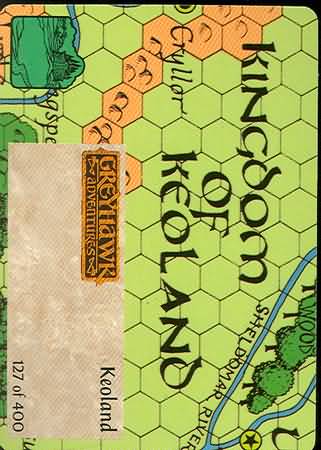Keoland, Kingdom Of

Keoland, Kingdom Of

|
|
|
|
|
|
|
|
|
|
|
|
His Peerless Majesty, the King of Keoland, Kimbertos Skotti; Lord of Gran March, Plar of Sterich; Protector of the South, etc. (R14)
CAPITAL: Niole Dra (pop. 21,600)
POPULATION: 300,000 (excluding dependencies)
DEMI-HUMANS: Sylvan Elves, Gnomes, Halflings
HUMANOIDS: Doubtful
RESOURCES: foodstuffs, cloth, gold, gems (III:
base value 100-500 gp)
ALIGNMENT: LN, NG, CG, CN, N
RACE: SOf
LANGUAGES: Common (15% Keolandish)
CLIMATE: Temperate
TERRAIN: Plains (Civilized)
Keoland was the first major kingdom to be established
in the Flanaess, the Oeridians and the Suloise
tribes mingling and joining to build a tolerant and
prosperous realm which nominally included
many
and varied demi-human groups as well. After several
centuries of benign leadership, a line of monarchs
upon the Keoish throne became ambitious and
embarked upon a policy of conquest. At the peak of
this imperialism, Keoland held sway from the Pomarj
to the Crystalmist Mountains, while her armies
pushed into Ket and threatened Verbobonc and Veluna
City (c. 350-360 CY). The Ketite expedition
came to grief in successive battles (Molvar, Lopolla),
while an alliance between Veluna and Furyondy
ended the Keoish threat in that quarter (Short War).
Coincidentally, the Olvenfolk within the boundaries
of Keoland objected to the warlike policies of the
King and began expelling royal garrisons in the Ulek
Provinces and Celene. In the ensuing struggle,
the
freemen of the western portion sided with the demi-humans.
Raiders in the far south took advantage of
these conditions to harry the Keoish coast from Gradsul
to Gryax.
King Tavish III was slain in battle against the Sea
Princes (Siege of Westkeep, 453 CY), and his son,
Tavish IV, immediately changed the policies of the
kingdom upon ascending to the throne. After protracted
negotiations, the independent state of the
Yeomanry was recognized, the Ulek states were
granted autonomy, and Keoland returned to its
former state of tolerance and prosperity thereafter.
The semi-independent Gran March and Earldom of
Sterich are loyal to the crown and furnish strong contingents
to the royal army. The Keolanders are well
known for their light cavalry employing javelins,
crossbows, and lances. The bulk of the army consists
of footmen armed with pole arms and long spears,
while the nobility comprises the heavy cavalry portion
of the force. There are typically small companies of
elves, gnomes, halflings, and/or dwarves included in
muster. The fleet is battleworthy but small, and conflict
with the Sea Princes continues to plague the
realm.
ENCOUNTERS
| Keoland | Encounter |
| 01 | Dwarves |
| 02 | Elves, High |
| 03-10 | Elves, Sylvan |
| 11-15 | Gnomes |
| 16 | Hobbits, Hairfeet |
| 17-18 | Hobbits, Stout |
| 19-20 | Hobbits, Tallfellows |
| 21-25 | Humanoids (01-05 = Gnoll*, 06-10 = Goblin, 11-15 = Hobgoblin, 16-94 = Orc**, 95 = Qullan, 96-100 = Xvart) |
| 26-29 | Men, Bandits |
| 30-31 | Men, Brigands |
| 32-43 | Men, Merchants |
| 44-50 | Men, Patrol, Light |
| 51-52 | Men, Pilgrims |
| 53-55 | Men, Tribesmen (marshmen)1 |
| 56-00 | USE Standard Encounter Tables |
1 Hillmen or marshmen in Keoland.
TEMPERATE CIVILIZED Plains and Scrub (d8+d12)
| 2 | Lammasu, Greater |
| 3 | Ghost |
| 4 | Lycanthrope, Wererat |
| 5 | Castle |
| 6 | Ankheg |
| 7 | Owl |
| 8 | Man, Pilgrim |
| 9 | Man, Bandit |
| 10 | Cattle, Wild |
| 11 | Man, Merchant |
| 12 | Falcon, Small |
| 13 | Man, Patrol |
| 14 | Character Party (RG) |
| 15 | Bugbear |
| 16 | Hobbit |
| 17 | Man, Dervish |
| 18 | Goblin |
| 19 | Oliphant |
| 20 | Quasi-elemental, Lightning |
![]()
Reduce - Reuse - Recycle